Brooklyn Bridge
| Brooklyn Bridge | |
|---|---|
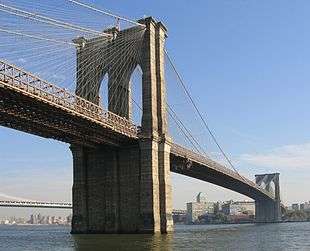 The Brooklyn Bridge, viewed from Manhattan | |
| Coordinates | 40°42′20″N 73°59′47″W / 40.70569°N 73.99639°WCoordinates: 40°42′20″N 73°59′47″W / 40.70569°N 73.99639°W |
| Carries |
6 lanes of roadway (cars only) Elevated trains (until 1944) Streetcars (until 1950) Pedestrians and bicycles |
| Crosses | East River |
| Locale | New York City (Civic Center, Manhattan – Dumbo/Brooklyn Heights, Brooklyn) |
| Maintained by | New York City Department of Transportation |
| Characteristics | |
| Design | Suspension/Cable-stay Hybrid |
| Total length | 5,989 ft (1,825.4 m)[1] |
| Width | 85 ft (25.9 m) |
| Height | 276.5 ft (84.3 m) above mean high water[2] |
| Longest span | 1,595.5 ft (486.3 m) |
| Clearance below | 135 ft (41.1 m) |
| History | |
| Designer | John Augustus Roebling |
| Opened | May 24, 1883[3] |
| Statistics | |
| Daily traffic | 123,781 (2008)[4] |
| Toll | Free both ways |
|
Brooklyn Bridge | |
 | |
| Built | 1883 |
| Architectural style | neo-Gothic |
| NRHP Reference # | 66000523 |
| Significant dates | |
| Added to NRHP | 1966[5] |
| Designated NHL | January 29, 1964[6] |
 Brooklyn Bridge Location in Lower Manhattan  Brooklyn Bridge Location in Lower Manhattan  Brooklyn Bridge Location in Lower Manhattan  Brooklyn Bridge Location in Lower Manhattan | |
The Brooklyn Bridge is a hybrid cable-stayed/suspension bridge in New York City and is one of the oldest bridges of either type in the United States. Completed in 1883, it connects the boroughs of Manhattan and Brooklyn by spanning the East River. It has a main span of 1,595.5 feet (486.3 m) and was the first steel-wire suspension bridge constructed. It was originally referred to as the New York and Brooklyn Bridge and as the East River Bridge, but it was later dubbed the Brooklyn Bridge, a name coming from an earlier January 25, 1867, letter to the editor of the Brooklyn Daily Eagle[7] and formally so named by the city government in 1915. Since its opening, it has become an icon of New York City and was designated a National Historic Landmark in 1964[6][8][9] and a National Historic Civil Engineering Landmark in 1972.[10]
Design
Although the Brooklyn Bridge is technically a suspension bridge,[11] it uses a hybrid cable-stayed/suspension bridge design. The towers are built of limestone, granite, and Rosendale cement. The limestone was quarried at the Clark Quarry in Essex County, New York.[12] The granite blocks were quarried and shaped on Vinalhaven Island, Maine, under a contract with the Bodwell Granite Company, and delivered from Maine to New York by schooner.[13]
The bridge was built with numerous passageways and compartments in its anchorages. New York City rented out the large vaults under the bridge's Manhattan anchorage in order to fund the bridge. Opened in 1876, the vaults were used to store wine, as they were always at 60 °F (16 °C).[14] This was called the "Blue Grotto" because of a shrine to the Virgin Mary next to an opening at the entrance. When New York visited one of the cellars about 102 years later, in 1978, it discovered, on the wall, a "fading inscription" reading: "Who loveth not wine, women and song, he remaineth a fool his whole life long."[15]
History
Construction
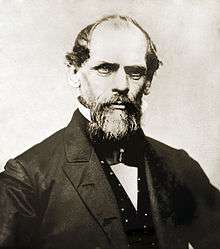
Construction of the bridge began in 1869.[11] The bridge was initially designed by German immigrant John Augustus Roebling, who had previously designed and constructed shorter suspension bridges, such as Roebling's Delaware Aqueduct in Lackawaxen, Pennsylvania, the Waco Suspension Bridge[16] and the John A. Roebling Suspension Bridge between Cincinnati, Ohio, and Covington, Kentucky. While conducting surveys for the bridge project, Roebling sustained a crush injury to his foot when a ferry pinned it against a piling. After amputation of his crushed toes he developed a tetanus infection which left him incapacitated and soon resulted in his death in 1869, not long after he had placed his 32-year-old son Washington Roebling in charge of the project.[17]
The bridge's two towers were built by floating two caissons, giant upside-down boxes made of southern yellow pine, in the span of the East River, and then beginning to build the stone towers on top of them until they sank to the bottom of the river. Compressed air was pumped into the caissons, and workers entered the space to dig the sediment, until the caissons sank to the bedrock. The whole weight of the bridge still sits upon a 15-foot thickness of southern yellow pine wood under the sediment.[18]
Many workers became sick with the bends in this work.[19] This condition was unknown at the time, and was first called "caisson disease" by the project physician Andrew Smith.[20][21] Washington Roebling also suffered a paralyzing injury as a result of decompression sickness shortly after ground was broken for the Brooklyn tower foundation on January 3, 1870.[22] Roebling's debilitating condition left him unable to physically supervise the construction firsthand.
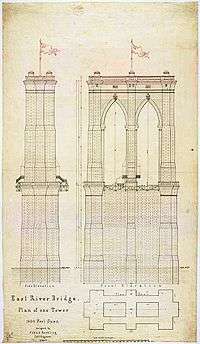
As Chief Engineer, Roebling supervised the entire project from his apartment with a view of the work, designing and redesigning caissons and other equipment. He was aided by his wife Emily Warren Roebling who provided the critical written link between her husband and the engineers on site.[23] Under her husband's guidance, Emily studied higher mathematics, the calculations of catenary curves, the strengths of materials, bridge specifications, and the intricacies of cable construction.[24][25][26] She spent the next 11 years assisting Washington Roebling, helping to supervise the bridge's construction. When iron probes underneath the caisson for the Manhattan tower found the bedrock to be even deeper than expected, Roebling halted construction due to the increased risk of decompression sickness. He later deemed the aggregate overlying the bedrock 30 feet (9 m) below it to be firm enough to support the tower base, and construction continued.[27]
The construction of the Brooklyn Bridge is detailed in the 1972 book The Great Bridge by David McCullough[23] and Brooklyn Bridge (1981), the first PBS documentary film by Ken Burns.[28] Burns drew heavily on McCullough's book for the film and used him as narrator.[29] It is also described in Seven Wonders of the Industrial World, a BBC docudrama series with accompanying book.
Opening


The bridge—originally referred to as the New York and Brooklyn Bridge and as the East River Bridge— was opened for use on May 24, 1883. The opening ceremony was attended by several thousand people and many ships were present in the East Bay for the occasion. President Chester A. Arthur and Mayor Franklin Edson crossed the bridge to celebratory cannon fire and were greeted by Brooklyn Mayor Seth Low when they reached the Brooklyn-side tower. Arthur shook hands with Washington Roebling at the latter's home, after the ceremony. Roebling was unable to attend the ceremony (and in fact rarely visited the site again), but held a celebratory banquet at his house on the day of the bridge opening. Further festivity included the performance of a band, gunfire from ships, and a fireworks display.[30]
On that first day, a total of 1,800 vehicles and 150,300 people crossed what was then the only land passage between Manhattan and Brooklyn. Emily Warren Roebling was the first to cross the bridge. The bridge's main span over the East River is 1,595 feet 6 inches (486.3 m). The bridge cost US$15.5 million in 1883 dollars (about US$381,589,000 in today's dollars) to build and an estimated 27 people died during its construction.[31]
On May 30, 1883, six days after the opening, a rumor that the bridge was going to collapse caused a stampede, which was responsible for at least twelve people being crushed and killed.[32] On May 17, 1884, P. T. Barnum helped to squelch doubts about the bridge's stability—while publicizing his famous circus—when one of his most famous attractions, Jumbo, led a parade of 21 elephants over the Brooklyn Bridge.[33][34][35][36]
At the time it opened, and for several years, it was the longest suspension bridge in the world—50% longer than any previously built—and it has become a treasured landmark. Since the 1980s, it has been floodlit at night to highlight its architectural features. The architectural style is neo-Gothic, with characteristic pointed arches above the passageways through the stone towers. The paint scheme of the bridge is "Brooklyn Bridge Tan" and "Silver", although it has been argued that the original paint was "Rawlins Red".[37]
At the time the bridge was built, the aerodynamics of bridge building had not been worked out. Bridges were not tested in wind tunnels until the 1950s, well after the collapse of the original Tacoma Narrows Bridge (Galloping Gertie) in 1940. It is therefore fortunate that the open truss structure supporting the deck is by its nature less subject to aerodynamic problems. Roebling designed a bridge and truss system that was six times as strong as he thought it needed to be. Because of this, the Brooklyn Bridge is still standing when many of the bridges built around the same time have vanished into history and been replaced. This is also in spite of the substitution of inferior quality wire in the cabling supplied by the contractor J. Lloyd Haigh—by the time it was discovered, it was too late to replace the cabling that had already been constructed. Roebling determined that the poorer wire would leave the bridge four rather than six times as strong as necessary, so it was eventually allowed to stand, with the addition of 250 cables. Diagonal cables were installed from the towers to the deck, intended to stiffen the bridge. They turned out to be unnecessary, but were kept for their distinctive beauty.
Renovation

After the collapse in 2007 of the I-35W highway bridge in the city of Minneapolis, increased public attention has been brought to bear on the condition of bridges across the US, and it has been reported that the Brooklyn Bridge approach ramps received a rating of "poor" at its last inspection.[38] According to a NYC Department of Transportation spokesman, it wasn't necessarily dangerous in the state it was then in, but a poor rating implied a renovation. A US$508 million project (equivalent to US$552 million in 2015)[39] to renovate the approaches began in 2010, with the full bridge renovation beginning in spring 2011, and was originally scheduled to run until 2014,[40] but project completion was later delayed to April 2015.[41]
As part of this project, two approach ramps were widened from one lane to two by re-striping a new prefabricated ramp; clearance over the eastbound Interstate 278 at York Street, on the double-deck Brooklyn-Queens Expressway, was increased; and seismic retrofitting, replacement of rusted railings and safety barriers, and road surface replacements were performed.[42] Due to the nature of the work, detours were necessitated for four years.[43]
In August 2016, after the renovation of the bridge had already been completed, the New York City Department of Transportation announced that it would conduct a seven-month, US$370,000 study to verify if the bridge could support a heavier upper deck that consisted of an expanded bicycle and pedestrian path. As of 2016, about 10,000 pedestrians and 3,500 bikers use the pathway on an average weekday.[44]
Notable events
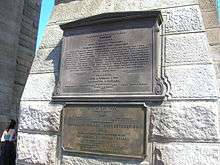
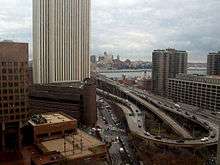
In 1915, the city government officially named the structure the Brooklyn Bridge,[45] a name first mentioned in print in a January 1867 letter to the editor of the Brooklyn Daily Eagle.[46]
In 1919, Giorgio Pessi piloted what was then one of the world's largest airplanes, the Caproni Ca.5, under the bridge.[47]
In 1964, the bridge was designated a National Historic Landmark, having become an icon of New York City since its opening,[8][9] and a National Historic Civil Engineering Landmark in 1972.[10]
The centennial celebrations on May 24, 1983, saw a cavalcade of cars crossing the bridge, led by President Ronald Reagan. A flotilla of ships visited the harbor, parades were held, and in the evening the sky over the bridge was illuminated by Grucci Fireworks.[48] The Brooklyn Museum exhibited a selection of the original drawings made for the bridge's construction, some by Washington Roebling himself. Media coverage of the centennial was declared "the public relations triumph of 1983" by Inc.[49]
In June 1993, following 13 reconnoiters inside the metal structure, and with the help of a mountain guide, Thierry Devaux performed (illegally) eight acrobatic bungee jumps above the East River close to the Brooklyn-side pier, in the early morning. He used an electric winch between each acrobatic figure.[50]
On March 1, 1994, Lebanese-born Rashid Baz opened fire on a van carrying members of the Chabad-Lubavitch Orthodox Jewish Movement, striking 16-year-old student Ari Halberstam and three others traveling on the bridge.[51] Halberstam died five days later from his wounds. Baz was apparently acting out of revenge for the Hebron massacre of 29 Palestinian Muslims by Baruch Goldstein that had taken place a few days earlier on February 25, 1994. Baz was convicted of murder and sentenced to a 141-year prison term. After initially classifying the murder as one committed out of road rage, the Justice Department reclassified the case in 2000 as a terrorist attack. The entrance ramp to the bridge on the Manhattan side was named the Ari Halberstam Memorial Ramp in memory of the victim.[52]
In 2003, truck driver Iyman Faris was sentenced to about 20 years in prison for providing material support to Al-Qaeda, after an earlier plot to destroy the bridge by cutting through its support wires with blowtorches was thwarted through information the National Security Agency uncovered through wiretapped phone conversations and interrogation of Al-Qaeda militants.[53]
In 2006, a Cold War-era fallout shelter was found during a structural inspection beneath the Manhattan approach. The abandoned space in one of the masonry arches still contained the emergency survival supplies for a potential nuclear attack by the Soviet Union.[54]
Beginning on May 22, 2008, festivities were held over a five-day period to celebrate the 125th anniversary of the opening of the Brooklyn Bridge. The events kicked off with a live performance of the Brooklyn Philharmonic in Empire–Fulton Ferry State Park, followed by special lighting of the bridge's towers and a fireworks display.[55] Other events held during the 125th anniversary celebrations, which coincided with the Memorial Day weekend, included a film series, historical walking tours, information tents, a series of lectures and readings, a bicycle tour of Brooklyn, a miniature golf course featuring Brooklyn icons, and other musical and dance performances.[56] Just before the anniversary celebrations, the Telectroscope, which created a video link between New York and London, was installed on the Brooklyn side of the bridge. The installation lasted for a few weeks and permitted viewers in New York to see people looking into a matching telectroscope in front of London's Tower Bridge.[57] A newly renovated pedestrian connection to the DUMBO neighborhood was also unveiled before the anniversary celebrations.[58]
On October 1, 2011, more than 700 protesters with the Occupy Wall Street movement were arrested while attempting to march across the bridge on the roadway.[59]

Early in the morning on July 22, 2014, the two American flags attached to poles atop each tower were found to have been replaced by American flags that had been bleached white. It is believed that several individuals covered the lights that illuminate the flags, then climbed the cables to the top of the two bridge towers. No motivation had yet been confirmed for this incident, but it had been suggested that the white flags were meant to symbolize surrender.[60][61][62] Evidence including surveillance footage and DNA taken from the bridge was reviewed,[63][64] and by August 1, 2014, up to nine "persons of interest" had been found, with a possible motive being cannabis activism.[65] However, on August 12, 2014, two Berlin artists claimed responsibility for hoisting the two white flags, causing the security panic and investigation by New York police. Mischa Leinkauf and Matthias Wermke said the flags were meant to celebrate "the beauty of public space" and the anniversary of the death of German-born John Roebling, who designed the famous bridge. The artists say they hand-sewed the two flags into all-white replicas of an American flag and had the original flags ready to return. "This was not an anti-American statement," Wermke said.[66][67][68]
There have been several notable jumpers as well. The first person to jump from the bridge was Robert Emmet Odlum, brother of women's rights activist Charlotte Odlum Smith, on May 19, 1885.[69][70] He struck the water at an angle and died shortly thereafter from internal injuries.[71] Steve Brodie dropped from underneath the bridge in July 1886, although there is some doubt about this. Larry Donovan made a slightly higher jump from the railing a month later and went on to an international bridge jumping career. Cartoonist Otto Eppers jumped and survived in 1910, and was then tried and acquitted for attempted suicide.[72] A lesser known early jumper was James Duffy of County Cavan, Ireland, who, on April 15, 1895, asked several men to watch him jump from the bridge. Duffy jumped and was not seen again.[73]
Pedestrian and vehicular access

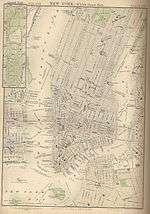
The bridge originally carried horse-drawn and rail traffic, with a separate elevated walkway along the centerline for pedestrians and bicycles. Since 1950, the main roadway has carried six lanes of automobile traffic. Due to the roadway's height (11 ft (3.4 m) posted) and weight (6,000 lb (2,700 kg) posted) restrictions, commercial vehicles and buses are prohibited from using this bridge. The two inside traffic lanes once carried elevated trains of the BMT from Brooklyn points to a terminal at Park Row via Sands Street. Streetcars ran on what are now the two center lanes (shared with other traffic) until the elevated lines stopped using the bridge in 1944, when they moved to the protected center tracks. In 1950, the streetcars also stopped running, and the bridge was rebuilt to carry six lanes of automobile traffic.
The Brooklyn Bridge is accessible for motor cars from the Brooklyn entrances of Tillary/Adams Streets, Sands/Pearl Streets, and Exit 28B of the eastbound Brooklyn-Queens Expressway. In Manhattan, motor cars can enter from either direction of the FDR Drive, Park Row, Chambers/Centre Streets, and Pearl/Frankfort Streets. Pedestrian and bicycle access to the bridge from the Brooklyn side is from either Tillary/Adams Streets (in between the vehicular entrance/exit) or a staircase on Prospect Street between Cadman Plaza East and West. In Manhattan, the pedestrian walkway is accessible from the end of Centre Street or through the unpaid south staircase of Brooklyn Bridge – City Hall / Chambers Street subway station complex.

The Brooklyn Bridge has a wide pedestrian walkway open to walkers and cyclists in the center of the bridge above the automobile lanes. In 1971, a center line was painted to separate cyclists from pedestrians, creating one of the City's first dedicated bike lanes.[74] More than 4,000 pedestrians and 3,100 cyclists cross the Brooklyn Bridge each day.[75] While the bridge has always permitted the passage of pedestrians across its span, its role in allowing thousands to cross takes on a special importance in times of difficulty when usual means of crossing the East River have become unavailable.
During transit strikes by the Transport Workers Union in 1980 and 2005, the bridge was used by people commuting to work, with Mayors Koch and Bloomberg crossing the bridge as a gesture to the affected public.[76][77]
Following the 1965, 1977, and 2003 blackouts and most famously after the September 11 attacks on the World Trade Center, the bridge was used by people leaving Manhattan after subway service was suspended. During the 2003 event, many crossing the bridge reported a swaying motion.[78] This swaying was caused by a much higher pedestrian load than usual, coupled with the tendency of pedestrians to synchronize their footfalls with a sway, amplifying the motion.[79] Several engineers expressed concern about how this would affect the bridge, although others noted that the bridge did withstand the event and that the redundancies in its design—the inclusion of the three support systems – suspension system, diagonal stay system, and stiffening truss—make it "probably the best secured bridge against such movements going out of control".[78] Previously, bridge designer John Roebling had stated that due to such redundancies, the bridge would sag, yet not fall, even if one of these structural systems were to fail altogether.[23]

Cultural significance
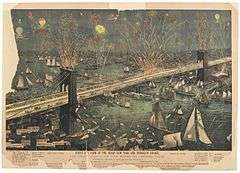
Contemporaries marveled at what technology was capable of, and the bridge became a symbol of the optimism of the time. John Perry Barlow wrote in the late 20th century of the "literal and genuinely religious leap of faith" embodied in the Brooklyn Bridge — "the Brooklyn Bridge required of its builders faith in their ability to control technology".[80]

References to "selling the Brooklyn Bridge" abound in American culture, sometimes as examples of rural gullibility but more often in connection with an idea that strains credulity. For example, "If you believe that, I've got a bridge to sell you." George C. Parker and William McCloundy are two early 20th-century con-men who had (allegedly) successfully perpetrated this scam on unwitting tourists.[81] The 1949 Bugs Bunny cartoon "Bowery Bugs" is also a joking reference to Bugs "selling" a story of the Brooklyn Bridge to a naive tourist.
A bronze plaque is attached to one of the bridge's anchorages, which was constructed on a piece of property occupied by a mansion, the Osgood House, at 1 Cherry Street in Manhattan. It served as the first Presidential Mansion, housing George Washington, his family, and household staff from April 23, 1789, to February 23, 1790, during the two-year period when New York City was the national capital. Its owner, Samuel Osgood, was a Massachusetts politician and lawyer, who married Maria Bowne Franklin, widow of Walter Franklin, the New York merchant who built it in 1770.[82] Washington moved in a week before his 1789 inauguration as first President of the United States. In addition to living quarters, the Osgood House contained the President's private office and the public business office, making it the first seat of the executive branch of the federal government.

"Love locks" is a practice by which a couple inscribes a date and their initials onto a lock, attach it to the bridge, and throw the key into the water as a sign of their "everlasting love". Although the origin of the practice is unknown, it is more popular in Europe, where more than 20 countries have at least one city with a similar location. It has reportedly caused damage to certain bridges and is officially illegal in New York City. The love locks are occasionally removed from the Brooklyn Bridge.[83]
In popular culture
- The bridge is often featured in wide shots of the New York City skyline in television and film. It has been shown in films such as Annie Hall, Gangs of New York, Kate & Leopold, It Happened in Brooklyn, Independence Day, I Am Legend, The Dark Knight Rises, Once Upon a Time in America, The Avengers, and Godzilla (in which the bridge is completely destroyed). It has also been prominently featured in various television series (especially those set in New York City), such as CSI: NY.
- Cuban poet José Martí wrote an article titled "The Bridge of Brooklyn" for the magazine La América, published in June 1883, shortly after the bridge opened to the public.[84] The article was published in his book "Escenas norteamericanas".[85] In the article, Martí made comparisons between certain animals (like snakes) and the structure of the bridge.[84]
- American Modernist poet Hart Crane used the Brooklyn Bridge as a central metaphor and organizing structure for his second and most important book of poetry, The Bridge. This book takes the form of a long poem spanning eight parts, beginning with an ode ("Proem: To Brooklyn Bridge") and ending with a transfigured vision of the bridge as the unifying symbol of America ("Atlantis"). Crane briefly lived in an apartment overlooking the bridge that, he later learned, once housed Washington Roebling, the Brooklyn Bridge's builder and son of its architect, John A. Roebling.
- Black American writer Samuel R. Delany makes extensive use of the Brooklyn Bridge in ATLANTIS: THREE TALES (1995), a collection of short stories. The first of these stories, "Atlantis: Model 1924" places the main character Sam (based on Delany's own father) on the bridge, where he coincidentally meets Hart Crane.[86]
- American playwright Mark Violi[87] has penned the drama Roebling: The Story of the Brooklyn Bridge.[88] This stage play focuses on the dramatic events of the Roebling family as they endeavor to build the Brooklyn Bridge. Tagline for the play reads: "A drama about the men who built the Brooklyn Bridge–and the woman who finished it."[89]
Gallery
.jpg) Under construction, c. 1872 – c. 1887
Under construction, c. 1872 – c. 1887 Brooklyn Bridge, looking west from Brooklyn, July 1899
Brooklyn Bridge, looking west from Brooklyn, July 1899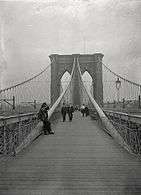 Brooklyn Bridge, looking east from Manhattan, July 1899
Brooklyn Bridge, looking east from Manhattan, July 1899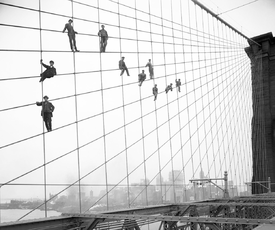 Painters working on the bridge, October 1914 (Eugene de Salignac)
Painters working on the bridge, October 1914 (Eugene de Salignac)- Base of Brooklyn tower
- Flag atop the bridge
.jpg) Pedestrian walkway
Pedestrian walkway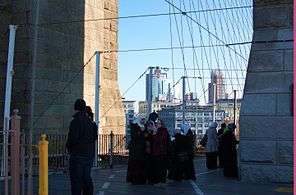 Pedestrian walkway between towers
Pedestrian walkway between towers.jpg) View of the support structure over the Brooklyn Bridge roadway
View of the support structure over the Brooklyn Bridge roadway.jpg) Westbound roadway, looking east at the bridge
Westbound roadway, looking east at the bridge View from Brooklyn
View from Brooklyn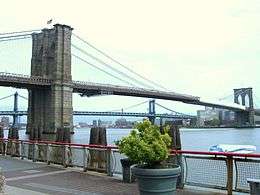 View from Manhattan
View from Manhattan- A bird soars over the Brooklyn Bridge


See also
References
Notes
- ↑ "NYCDOT Bridges Information". New York City Department of Transportation. Retrieved August 23, 2008.
- ↑ "Brooklyn Bridge". Nycroads.com. Retrieved June 4, 2013.
- ↑ Feuerstein, Gary (May 29, 1998). "Brooklyn Bridge Facts, History and Information". Endex.com. Archived from the original on February 8, 2010. Retrieved May 23, 2011.
- ↑ "New York City Bridge Traffic Volumes 2008" (PDF). New York City Department of Transportation. March 2010. p. 63. Retrieved July 10, 2010.
- ↑ National Park Service (2007-01-23). "National Register Information System". National Register of Historic Places. National Park Service.
- 1 2 "Brooklyn Bridge". National Park Service. Archived from the original on November 28, 2002.
- ↑ E.P.D. (January 25, 1867). "Bridging the East River – Another Project". The Brooklyn Daily Eagle. p. 2. Archived from the original on October 19, 2007. Retrieved November 26, 2007.
- 1 2 Armstrong, James B.; Bradford, S. Sydney (February 24, 1975). "The Brooklyn Bridge" (PDF). National Register of Historic Places Inventory-Nomination. National Park Service.
- 1 2 "The Brooklyn Bridge—Accompanying three photos, from 1975." (PDF). National Register of Historic Places Inventory-Nomination. National Park Service. February 24, 1975.
- 1 2 "Brooklyn Bridge". ASCE Metropolitan Section. Retrieved November 12, 2016.
- 1 2 "Brooklyn Bridge", Encyclopedia Britannica
- ↑
- "Cultural Resource Information System (CRIS)" (Searchable database). New York State Office of Parks, Recreation and Historic Preservation. Retrieved February 1, 2016.
- William E. Krattinger; Darcey Hale; Bruce Hale & Morris Glenn (August 2012). "National Register of Historic Places Registration Form: Ligonier Point Historic District" (PDF). Retrieved February 1, 2016.
- ↑ McLane, Charles B.; McLane, Carol Evarts (1997). Islands of the Mid-Maine Coast. I. Tilbury House & Island Institute. p. 134. ISBN 0-88448-184-0.
- ↑ "Brooklyn Bridge Champagne". ediblegeography.com.
- ↑ Van Luling, Todd (April 17, 2014). "8 Things Even New Yorkers Don't Know About New York City". The Huffington Post.
- ↑ http://www.1000friendsofwaco.com/wp-content/Waco-Suspension-Bridge-story.pdf
- ↑ "The Building Of The Bridge.; Its Cost And The Difficulties Met With-- Details Of The History Of A Great Engineering Triumph.". The New York Times. May 24, 1883. Retrieved October 27, 2009.
- ↑ McNamara, Robert. "The Brooklyn Bridge was a Fascinating Sight While Being Built". about education. About.com. Retrieved October 31, 2015.
- ↑ "Sandhog: Building the Brooklyn Bridge, 1871". Eyewitness to History. Retrieved October 31, 2015.
- ↑ Smith, Andrew Heermance (1886). The Physiological, Pathological and Therapeutical Effects of Compressed Air. Detroit: George S. Davis. Retrieved April 17, 2009.
- ↑ Acott, Chris (1999). "A brief history of diving and decompression illness.". South Pacific Underwater Medicine Society journal. 29 (2). ISSN 0813-1988. OCLC 16986801. Retrieved April 17, 2009.
- ↑ Butler WP (2004). "Caisson disease during the construction of the Eads and Brooklyn Bridges: A review". Undersea Hyperb Med. 31 (4): 445–59. PMID 15686275. Retrieved June 19, 2008.
- 1 2 3 McCullough, David (1972). The Great Bridge. New York: Simon & Schuster. ISBN 978-0-671-21213-1.
- ↑ Weigold, Marilyn (1984). Silent Builder: Emily Warren Roebling and the Brooklyn Bridge. Associated Faculty Press.
- ↑ McCullough, David (1983). The Great Bridge: The Epic Story of the Building of the Brooklyn Bridge. New York: Simon & Schuster. p. 421.
- ↑ "Emily Warren Roebling". American Society of Civil Engineers. Retrieved June 30, 2010.
- ↑ "GlassSteelandStone: Brooklyn Bridge-tower rests on sand". Retrieved February 20, 2007.
- ↑ Burns, Ken. "Why I Decided to Make Brooklyn Bridge". Public Broadcasting Service. Retrieved February 20, 2010.
- ↑ "Burns, Ken – U.S. Documentary Film Maker". The Museum of Broadcast Communications. Retrieved February 20, 2010.
- ↑ Reeves, Thomas C. (1975). Gentleman Boss. New York: Alfred A. Knopf. pp. 359–360. ISBN 0-394-46095-2.
- ↑ "Brooklyn Daily Eagle 1841–1902 Online". Archived from the original on November 14, 2007. Retrieved November 23, 2007.
- ↑ "Dead on the New Bridge; Fatal Crush at the Western Approach". The New York Times. May 31, 1883. Retrieved February 20, 2010.
- ↑ Bildner, Phil (2004). Twenty-One Elephants. New York: Simon & Schuster. ISBN 0-689-87011-6.
- ↑ Prince, April Jones (2005). Twenty-One Elephants and Still Standing. Boston: Houghton Mifflin. ISBN 0-618-44887-X.
- ↑ P.T. Barnum – MSN Encarta. Archived from the original on October 31, 2009.
- ↑ Strausbaugh, John (November 9, 2007). "When Barnum Took Manhattan". The New York Times. Retrieved September 21, 2008.
- ↑ Gary Buiso, New York Post (May 25, 2010). "A True Cover Up. Brooklyn Bridge Paint Job Glosses over History". Retrieved October 23, 2010.
- ↑ Chan, Sewell (August 2, 2007). "Brooklyn Bridge Is One of 3 With Poor Rating". The New York Times. Retrieved September 10, 2007.
- ↑ Federal Reserve Bank of Minneapolis Community Development Project. "Consumer Price Index (estimate) 1800–". Federal Reserve Bank of Minneapolis. Retrieved October 21, 2016.
- ↑ "Brooklyn Bridge construction starts Aug. 23, keeping Manhattan-bound lanes closed nights till 2014". New York Daily News. Retrieved September 11, 2012.
- ↑ "Brooklyn Bridge Rehabilitation Spring 2014 Newsletter" (PDF). New York City Department of Transportation. Retrieved September 9, 2014.
- ↑ "Rebuilding the Bridge". New York City Department of Transportation. Retrieved September 11, 2012.
- ↑ "Rebuilding the Bridge — brochure" (PDF). New York City Department of Transportation. Retrieved September 9, 2014.
- ↑ Hu, Winnie (2016-08-08). "Brooklyn Bridge, the 'Times Square in the Sky,' May Get an Expansion". The New York Times. ISSN 0362-4331. Retrieved 2016-08-08.
- ↑ Leonard Benardo; Jennifer Weiss (2006). Brooklyn by Name: How the Neighborhoods, Streets, Parks, Bridges, and More ... NYU Press. Retrieved April 2, 2015.
A Board of Aldermen resolution on January 26, 1915, made it official.
- ↑ E.P.D. (January 25, 1867). "Bridging the East River – Another Project". The Brooklyn Daily Eagle. p. 2. Archived from the original on October 19, 2007. Retrieved November 26, 2007.
- ↑ Franks, Norman et al. (1997) Above the War Fronts: The British Two-seater Bomber Pilot and Observer Aces, the British Two-seater Fighter Observer Aces, and the Belgian, Italian, Austro-Hungarian and Russian Fighter Aces, 1914–1918: Volume 4 of Fighting Airmen of WWI Series: Volume 4 of Air Aces of WWI. Grub Street, 1997. pp. 150-151. ISBN 1-898697-56-6, ISBN 978-1-898697-56-5.
- ↑ NYC Roads. "The Brooklyn Bridge". Retrieved October 23, 2010.
- ↑ Hartman, Curtis (November 1, 1983). "Selling the Brooklyn Bridge". Inc. Retrieved January 9, 2012.
- ↑ "Brooklyn Bridge". SunnyDream. Retrieved June 25, 2010.
- ↑ Sexton, Joe (March 2, 1994). "4 Hasidic Youths Hurt in Brooklyn Bridge Shooting". The New York Times. Retrieved June 30, 2010.
- ↑ "In Memoriam". Ari Halberstam Memorial Site. Retrieved June 30, 2010.
- ↑ "Iyman Faris". GlobalSecurity.org. Retrieved June 30, 2010.
- ↑ Lovgren, Stefan (March 24, 2006). "Cold War "Time Capsule" Found in Brooklyn Bridge". National Geographic. Retrieved February 20, 2010.
- ↑ Burke, Kerry; Hutchinson, Bill (May 23, 2008). "Brooklyn Bridge turns 125 with a bang". Daily News. New York. Retrieved August 1, 2009.
- ↑ "Brooklyn Bridge 125th Anniversary Celebration". ASCE Metropolitan Section. Retrieved November 12, 2016.
- ↑ Ryzik, Melena (May 21, 2008). "Telescope Takes a Long View, to London". The New York Times. Retrieved August 1, 2009.
- ↑ Farmer, Ann (May 21, 2008). "This Way to Brooklyn, This Way". The New York Times. Retrieved August 1, 2009.
- ↑ Baker, Al; Moynihan, Colin; Nir, Sarah Maslin (October 1, 2011). "Police Arrest More Than 700 Protesters on Brooklyn Bridge". The New York Times. Retrieved December 11, 2011.
- ↑ American Flags Bleached White Appear Atop Brooklyn Bridge | NBC New York | Retrieved July 23, 2014
- ↑ White flags stump New York police | BBC News | Retrieved July 23, 2014
- ↑ A Brooklyn Bridge Mystery: Who Raised the White Flags? | The New York Times | Retrieved July 23, 2014
- ↑ Video in Bridge Flag Probe Studied | NBC New York | Retrieved July 26, 2014
- ↑ "Bridge Flag Probe Includes DNA". NBC New York. Retrieved July 26, 2014.
- ↑ "Cops closing in on Brooklyn Bridge white flag suspects". New York Post. August 1, 2014. Retrieved August 2, 2014.
- ↑ "Germans Put Flags on Brooklyn Bridge". Daily Beast. August 12, 2014. Retrieved August 12, 2014.
- ↑ "Artists Claim Brooklyn Bridge Stunt". BBC News. Retrieved August 13, 2014.
- ↑ "Artists Claim White Flags on Bridge". NBC New York. Retrieved August 13, 2014.
- ↑ Catherine Odlum (1885). The Life and Adventures of Prof. Robert Emmet Odlum, Containing an Account of his Splendid Natatorium at the National Capital. Gray and Clarkson.
- ↑ Stanley, Autumn (2009). Raising More Hell and Fewer Dahlias: The Public Life of Charlotte Smith, 1840–1917. Bethlehem: Lehigh University Press. ISBN 978-0-934223-99-7.
- ↑ "Odlum's Leap to Death". The New York Times. May 20, 1885. p. 1. Retrieved April 15, 2008.
- ↑ Abstract of "Youth Dives Off Brooklyn Bridge; Youngster Eludes the Police and Plunges Into the East River, Escaping Unhurt", The New York Times', n.d.
- ↑ "Warren sheaf". Chronicling America: Historic American Newspapers. Warren, Marshall County, Minn.: Library of Congress. April 18, 1895.
- ↑ "Brooklyn Bridge Opens Special Bicycle Ramps". New York Times. April 1, 1971.
- ↑ "Brooklyn Bridge". NYC DOT. Retrieved March 22, 2016.
- ↑ Quindlen, Anna (April 2, 1980). "Koch Faces Day Ebulliently; He Looks Well Rested". The New York Times. Retrieved June 30, 2010.
- ↑ Rutenberg, Jim (December 21, 2005). "On Foot, on Bridge and at City Hall, Bloomberg Is Irate". The New York Times. Retrieved June 30, 2010.
- 1 2 Julavits, Robert (August 26, 2003). "Point of Collapse". The Village Voice. Retrieved January 17, 2016.
- ↑ Strogatz, Steven (2003). Sync: The Emerging Science of Spontaneous Order. New York: Hyperion. pp. 174–175, 312, 320. ISBN 0-7868-6844-9.
- ↑ Barlow, John Perry (March 21, 1995). "The View from the Brooklyn Bridge In response to "The Five Imperatives for Electronic Trade"". Electronic Frontier Foundation. Retrieved March 22, 2016.
- ↑ Cohen, Gabriel (November 27, 2005). "For You, Half Price". The New York Times. Retrieved February 20, 2010.
- ↑ "A Historic Home Marked". The New York Times. May 2, 1899. Retrieved December 11, 2011.
- ↑ Love locks appear on Brooklyn Bridge, Daily mail online, February 18, 2013, Retrieved September 11, 2013.
- 1 2 Martí, José. "El puente de Brooklyn" (PDF) (in Spanish). Retrieved March 4, 2012.
- ↑ Sampath Nelson, Emmanuel (2005). The Greenwood Encyclopedia of Multiethnic American Literature: I — M. Greenwood. p. 2692. ISBN 978-0-313-33059-9.
- ↑ Delany, Samuel R. (1995). ATLANTIS: THREE TALES. Wesleyan University Press. p. 59. ISBN 0-8195-6312-9.
- ↑ Mark Violi
- ↑ Roebling: The Story of the Brooklyn Bridge
- ↑ "Roebling: The Story of the Brooklyn Bridge by Mark Violi | Brooklyn Bridge Stage Play Drama". www.roeblingplay.com. Retrieved 2016-07-25.
Further reading
- Cadbury, Deborah (2004). Dreams of Iron and Steel. New York: HarperCollins. ISBN 0-00-716307-X.
- Haw, Richard (2005). The Brooklyn Bridge: A Cultural History. New Brunswick: Rutgers University Press. ISBN 0-8135-3587-5.
- Haw, Richard (2008). Art of the Brooklyn Bridge: A Visual History. New York: Routledge. ISBN 0-415-95386-3.
- Kingsley, William C.; Low, William Seth; Edson, Franklin (1883). Opening Ceremonies of the New York and Brooklyn Bridge, May 24, 1883. Brooklyn, New York: Press of the Brooklyn eagle job printing Dept.
- McCullough, David (1972). The Great Bridge. New York: Simon & Schuster. ISBN 978-0-671-21213-1.
- Morris, John G. (May 1983). "The Wonderful Brooklyn Bridge". National Geographic. Vol. 163 no. 5. pp. 565–579. ISSN 0027-9358. OCLC 643483454.
- Odlum, Catherine (1885). The Life and Times of Prof Robert Emmet Odlum. Washington, DC: Gray & Clarkson.
- Stern, John; Wilson, Carrie (2003). The Brooklyn Bridge: A Study in Greatness (PDF). New York: Aesthetic Realism Looks at NYC.
- Strogatz, Steven (2003). Sync: The Emerging Science of Spontaneous Order. New York: Hyperion Books. ISBN 978-0-7868-6844-5.
- Strogatz, S. H.; Abrams, D. M.; McRobie, A.; Eckhardt, B.; Ott, E. (2005). "Theoretical mechanics: Crowd synchrony on the Millennium Bridge". Nature. 438 (7064): 43–44. doi:10.1038/438043a. PMID 16267545.
- Trachtenberg, Alan (1965). Brooklyn Bridge: Fact and Symbol. Chicago: University of Chicago Press. ISBN 0-226-81115-8.
- "Brooklyn Bridge and its Railway". The Catskill Archive.
-
 "The Great Bridge and its Lessons" in Popular Science Monthly Volume 23, July 1883
"The Great Bridge and its Lessons" in Popular Science Monthly Volume 23, July 1883
-
 "Constructive Elements of the East River Bridge" in Popular Science Monthly Volume 23, July 1883
"Constructive Elements of the East River Bridge" in Popular Science Monthly Volume 23, July 1883
External links
| Wikimedia Commons has media related to Brooklyn Bridge. |
- Brooklyn Bridge – New York City Department of Transportation
- Brooklyn Bridge: Historic overview - NYCRoads.com
- Great Buildings entry for the Brooklyn Bridge
- Brooklyn Bridge at Structurae
- Historic American Engineering Record (HAER) No. NY-18, "Brooklyn Bridge"
- Brooklyn Bridge at Historical Marker Database
- "Brooklyn Bridge collected news and commentary". The New York Times.

